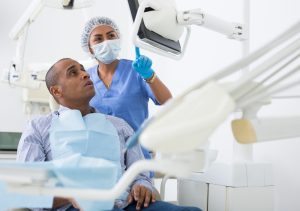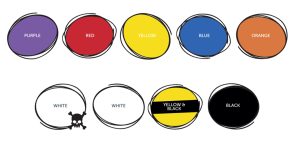
Dentistry is inherently patient-centred. Each individual contaminates the items used during their treatment, which must then be appropriately treated or disposed of before another patient can be cared for.
Many single-use items will be discarded immediately into the waste workflow. In these instances, clinicians must be aware of how the interaction between a patient and a disposable item can change the waste stream that it should enter. Correctly segregating waste according to current guidance prevents further infection risks for staff and patients alike, so adequate knowledge of the waste workflow is key.
Drawing the infectious line
Clinicians should always look to Health Technical Memorandum 07-01 (HTM 07-01), a central piece of guidance for healthcare professionals, when organising the waste workflow. It can feel easy to get lost in technicoloured flowcharts and Venn diagrams, but the colour-coded waste segregation is simple to understand and offers protection for dental teams and patients, as well as the wider environment in line with the NHS Clinical Waste Strategy.[1]

Patients affect the division of waste products due to infection risks that they present. This could be due to temporary or long-standing illness. Clinicians need to identify the level of infection risk, and segregate waste items with this information.
In the colour code set out by HTM 07-01, yellow waste containers are for infectious, medical and some anatomical waste that are contaminated with pharmaceutical or chemical residues that require incineration or alternative treatment. Orange containers are for known infectious items (without other hazards) that may undergo alternative treatment or incineration, though the latter is not recommended under the waste hierarchy.
Identifying an infectious item after it has been in contact with a patient can be difficult; there is no feasible way to test every item for viable microorganisms that present a substantial risk, so clinicians need to use their professional judgement before using either of these waste containers. If the patient is being treated for infection or is carrying a transmissible disease, waste items that have come into contact with them are likely to be infectious.1 The same sentiment applies to individuals with a history of a known infection, for example a bloodborne virus. This may appear in their previous medical history.
Once this is established by the dental professional, the contaminated waste items will be placed in the yellow containers if there is also a chemical or medicinal contamination, or into the orange bins if infection is the only risk. One example of an item placed into a yellow container would be a single-use needle for local anaesthetic that has been provided to a patient with an infection – a sharps disposal bin would be needed here, of course.
When in doubt
The impact of a patient with an infection is clear, but in many other instances it is possible to safely assign items as offensive waste.
Offensive and infectious waste is clearly distinguishable and should be separated as such. The NHS Clinical Waste Strategy aimed to change the volume of each type of waste generated through healthcare, with 60% being designated as offensive waste, 20% of items being yellow and the final 20% as orange bagged waste.[2] To avoid the excessive attribution of “infectious” status to waste items, a revised HTM 07-01 instructs clinicians to not use a yellow or orange container if there is no good reason to believe that an item is hazardous.1
Offensive waste is titled as such due to a potentially unpleasant odour and/or appearance, even though some items may not be readily “offensive” to a dental professional. Used PPE is such an example. Whilst a dental practitioner’s glove may have some saliva on it after treating a patient, unless the patient has an infection, this will be considered offensive waste. Items contaminated with blood can also be designated as offensive waste where no hazard is deemed present.
Prepare the practice
The dental practice needs to be able to manage waste safely after patient interactions, including both hazardous and offensive items. Likewise, the dental team needs to be knowledgeable about when to segregate waste based on the hazards presented.
Clinical waste bags and containers at the point of use ensure clinicians can safely dispose of items immediately after treating a patient. Initial Medical, the renowned clinical waste management service based throughout the UK, provides a range of solutions that fit every dental practice. Clinicians can choose colour-coded clinical waste bags to fit the clinical waste workflow, each made of 30% recycled plastic and designed to be tear and impact resistant. Initial Medical also provides FREE colour coding posters online, which can be placed around the practice as helpful reminders for each team member.
The condition of a patient heavily impacts upon the practice’s waste management workflow. Effectively identifying when hazards are present makes the waste segregation process simple, for safer outcomes.

To find out more, get in touch at 0808 304 7411 or visit the website today www.initial.co.uk/medical

Rebecca Waters
Rebecca has worked in the healthcare sector for the past 20 years and earned a BSc Chemistry (Hons) prior to joining Rentokil Initial in 2003. She works within the Research and Development team and keeps up-to-date on all changes within the clinical waste management industry, as well as the specialist hygiene and infection control industries, and is an active member of the CIWM and HWMA. Following roles as an Analytical Chemist and Hygiene Chemist, she has worked in a variety of leading marketing roles since 2006, making her an expert within the industry. She is a Fellow at the Chartered Institute of Marketing, an FCIM. Rebecca loves spending time outdoors and in the water – whether walking, camping, or swimming – and completed a focus on environmental studies during her university degree. She is proud to be pushing a sustainability agenda throughout her work.
About Initial Medical
Initial Medical set the standard in healthcare and infectious waste management in the UK, providing a reliable, effective and fully compliant service built around customer needs and delivered by our highly trained local teams. We are ISO 9001:2015 accredited, with technology fully integrated into our operations, providing full traceability of service delivery, electronic waste documentation and the best customer experience possible. We also offer innovative healthcare waste management services and infection control products, to help break the chain of transmission and prevent cross contamination.
Initial Medical are a company with a ‘World Class’ Health and Safety record, and ISO 45001:2018 accreditation. We are also accredited to ISO 14001:2015 environmental standards, and pride ourselves on our sustainable approach with a focus on delivering eco-friendly products and operational solutions.
Media enquiries:
For more information, please contact:
01227 265700
[1] NHS England, (2022). Health Technical Memorandum 07-01: Safe and sustainable management of healthcare waste. (Online) Available at: https://www.england.nhs.uk/wp-content/uploads/2021/05/B2159iii-health-technical-memorandum-07-01.pdf [Accessed May 2025]
[2] NHS England, (2023). NHS clinical waste strategy. (Online) Available at: https://www.england.nhs.uk/estates/nhs-clinical-waste-strategy/ [Accessed May 2025]




